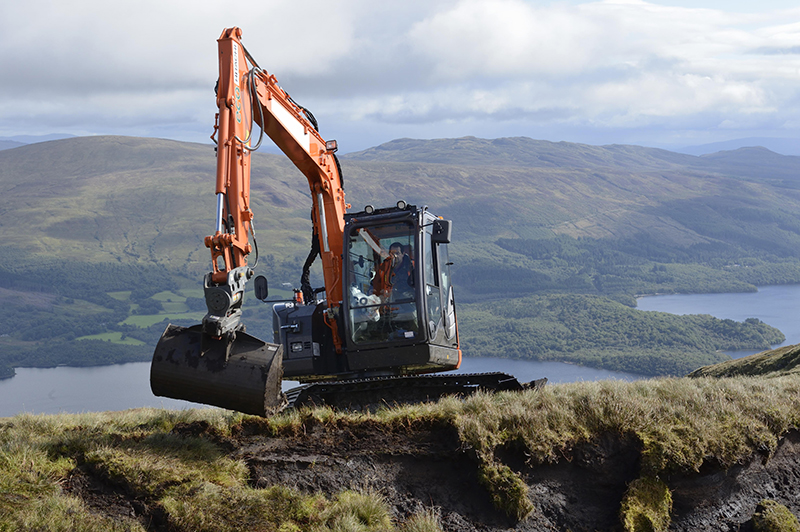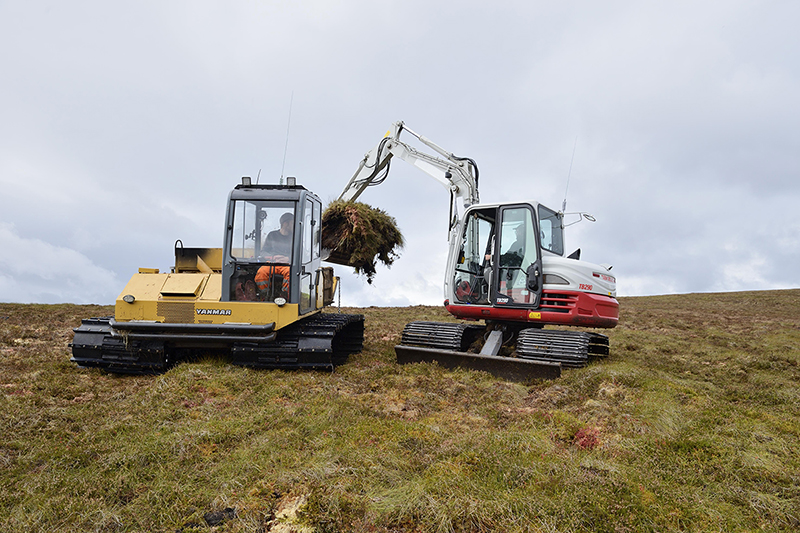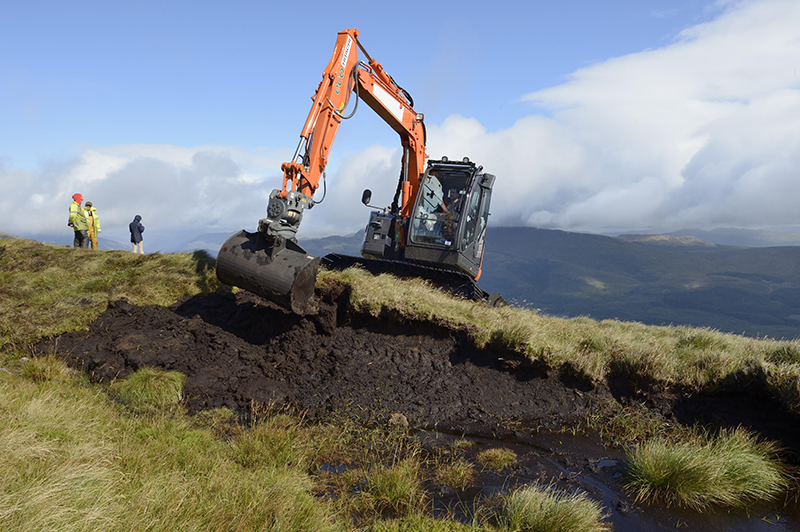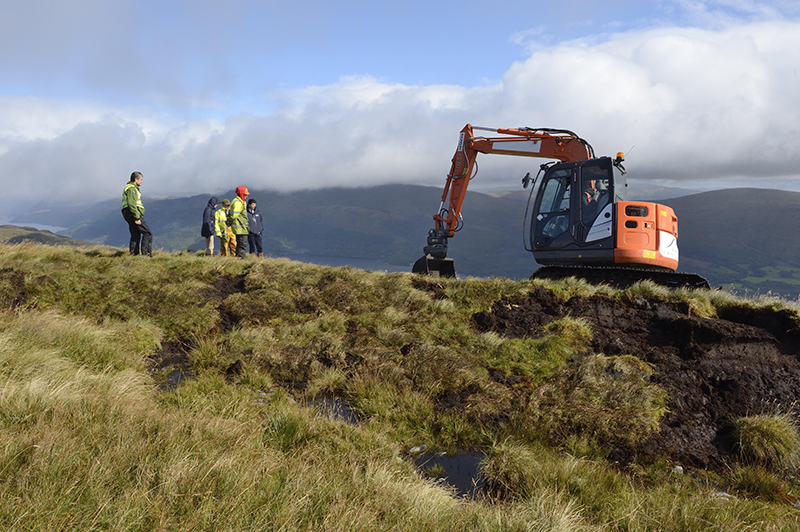
SCOTLAND’S plant operators have been lauded for the ‘fundamental’ role they have played in peatland restoration projects across the country.
For the past ten years, operators and contractors have been involved in helping to restore damaged peatlands in an effort to improve Scotland’s environmental credentials.
Experienced excavator operators have been highly influential in the development of techniques to accelerate the progress of this rapidly growing area of work.
Representatives from Peatland ACTION – the national programme to restore peatlands across Scotland funded by the Scottish Government and delivered by NatureScot, Forestry and Land Scotland, the two national park authorities, and Scottish Water – attended ScotPlant last year to raise awareness of the opportunities available to individuals from the construction equipment sector.
Following a flurry of interest, the organisation is now ramping up its training programme.

Becky Shaw, Workforce Planning and Development Manager at Peatland ACTION, told Project Plant that peatlands are defined as wetland ecosystems in which waterlogged conditions prevent plant material from fully decomposing. As a result, the production of organic matter exceeds its decomposition, which causes a net accumulation of peat.
Peatland restoration has been identified as playing a significant role in Scotland’s response to the climate emergency because when peat is exposed or its hydrology becomes modified, carbon is emitted in the form of greenhouse gases. The aim of peatland restoration is to reverse this trend and ensure peatland acts as a carbon sink. There are also important biodiversity benefits.
Peatland ACTION aims to deliver 250,000 hectares of restored peatlands by 2030, but the process is challenging, not least because it is often carried out in remote and rural areas.
“Scotland has around two million hectares of peatland,” Becky explained. “Around 75% of that is degraded. Degraded peat is contributing about 15% of Scotland’s greenhouse gas emissions at the moment so it’s really significant.
“The purpose of the Peatland ACTION programme is to restore the functioning hydrology of the peatland. Peatland ACTION provides funding for restoration. It can also provide the support, the advice, and development of actual peatland restoration schemes on behalf of the landowner.”

Since 2012, Peatland ACTION has restored over 35,000 hectares of peatland. Projects have taken place all over the country, with peatland being particularly prominent in areas such as the Highlands and Islands and south-west Scotland.
One high-profile project is at Forsinard in the Flow Country. Called ‘Flows to the Future’, the aim is to restore areas of blanket bog in Caithness and Sutherland. A huge amount of work has been done to raise the water table of the peatland and return it to as close to its natural ecosystem as possible.
Significant research and monitoring has been carried out in the area to see how blanket bog responds to particular restoration techniques.
This project is one example of the type of rural and/or remote locations in which peatlands are commonly found. Becky revealed such sites bring obvious logistical challenges.
“Peatlands are often in pretty remote areas; sometimes they are relatively accessible and close to the road, but in a lot of cases you’re talking about places that are quite remote from easy access,” she added. “You might have to travel a couple of miles along an estate track or forest road. Or park in a particular place and then walk half a mile up a hill to your machine. Sometimes these are relatively high altitude (locations) so you’re pretty exposed to the elements.”
A further challenge surrounds the time of year this work can be carried out. Until recently, no peatland restoration work could take place through the breeding bird season from early April to August. This has been eased somewhat by the introduction of a breeding bird protocol, which sets out an approach to managing the risk of disturbing bird nesting via a series of surveys and risk management solutions which allow, where possible, some sites to continue working.

Becky hailed the role that the construction industry has played in the peatland restoration process, advising that an array of potential employment opportunities exist.
“You’ve got an army of people doing the surveys, testing the depth of the peat, drawing up the design schemes, and bringing it through the grant process and so on,” Becky stated. “All of that then hinges on people on the machines actually delivering the work. Peatland restoration is predominantly done with excavators. The delivery of the work on the ground is entirely dependent on skilled machine operators.”
In terms of who this is likely to appeal to, Becky highlighted individuals who enjoy rural locations and those not put off by the relatively isolated nature of the work.
“You’ll be able to see other people, but you may be a few hundred metres across a hillside working away on your own,” she added. “I guess it also appeals to people who have a genuine interest in doing something on the land, or if you’re interested in what’s happening on the ground and comfortable with moving a machine across a fragile wet environment.
“I saw a contractor advertising for staff recently to work on peatland restoration and forestry-related (tasks), asking for a basic level of mechanical competence because sometimes you are quite isolated and if you can do straightforward fixing of things yourself, that would be an advantage. The support provided to you might be a wee while in coming.”
Eight and 14-tonne excavators are the most commonly used machines involved in peatland restoration. Tiltrotators have also proved beneficial, while low ground pressure is crucial.
Many of the techniques utilised have been honed and perfected by the operators themselves.
“A number of people have been working with Peatland ACTION now for the full ten years that it’s been running and there’s some real expertise in the contracting community,” Becky revealed. “A lot of the modification of techniques have come from really experienced operators saying to the scheme designer: ‘Do you think we should do that this way? ’ Some of the more experienced contractors have contributed really significantly towards developing techniques because this is a brand new industry basically, a brand new sector.
“There’s also significant numbers of people who are keen to become involved in peatland restoration. At ScotPlant last year we were really taken by how many folk came specifically to speak to us because they wanted to know more about peatland restoration and how to get involved. That’s given us the impetus to increase our training effort to make sure people who are interested can find a way to learn the techniques that are important for the sector.”
A Peatland ACTION training programme has been in operation since 2017.
Delivered via the organisation’s partners at Crichton Carbon Centre in Dumfries and Galloway, two-day training events cover the theory and principles behind peatland restoration.
An indoor aspect provides an understanding of degraded peatland and what is trying to be achieved. This is followed by a site visit and delving into specific techniques.
The Peatland ACTION website also features information and videos for those wanting to find out more, while a technical compendium has been launched, containing the shared experience of people who have been doing the work for a long time about the techniques that may be most applicable to a particular situation.
Peatland ACTION is also developing more targeted training, such as a pre-apprenticeship.
A new entrant scheme, which involves training and mentoring for existing machine operators who are looking for experience on peatland, is also being piloted.
• For more information, visit nature.scot/peatlandaction








